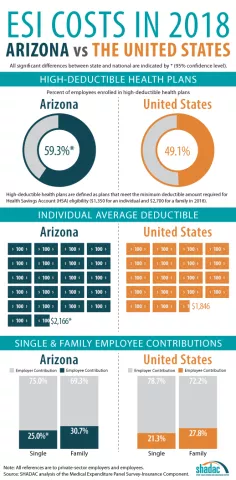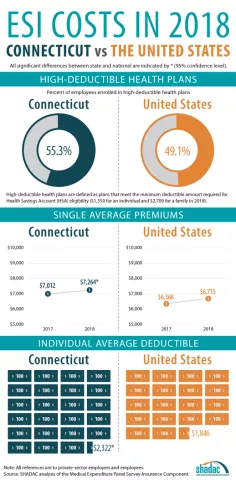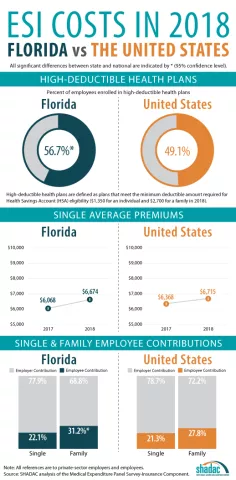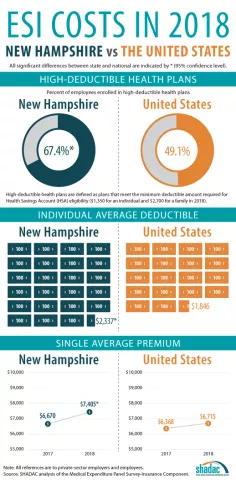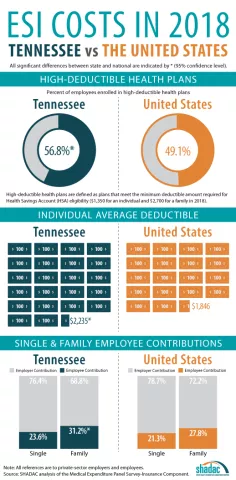High health care costs have increasingly been a concern across the United States. Though presidential candidates have recently put forth proposals for changing the role of private insurance within the health care system, recent polls suggest that American consumers would rather hear about plans to lower the rising costs paid by individuals, such as deductibles and copays.[i]
Findings from SHADAC’s analysis of employer-sponsored insurance (ESI) in 2018 back up these consumer concerns. Researchers noted that employees on average paid higher-than-ever premiums ($6,715 for single coverage and $19,565 for family) and deductibles ($1,846 and $3,392 for single and family coverage, respectively) for their health plans last year. Rising costs have also led to record enrollment in high-deductible health plans (HDHPs), with nearly half of workers (49.1 percent) enrolled in such a plan in 2018.[ii]
Using data from Medical Expenditure Panel Survey Insurance Component (MEPS-IC), SHADAC has conducted a deeper dive into a state-level analysis of ESI trends in order to better understand which states are most affected by increasing premiums and deductibles or might have a population with high enrollment in HDHPs, leaving them financially vulnerable in case of an unexpected health crisis that leads to large medical bills.
We compared costs in four categories—high-deductible health plan enrollment, average annual deductibles for single and/or family coverage, average annual premiums for single and/or family coverage, and annual employee contributions for single and/or family coverage—for individual states and the United States, and identified five states (Arizona, Connecticut, Florida, New Hampshire, and Tennessee) where costs were significantly higher than the national average for last year across multiple (though not all) categories of ESI coverage.
Five States with the Highest ESI Costs Compared with the National Average
Arizona
In Arizona, the percent of employees enrolled in high-deductible health plans (HDHPs) was 59.3 in 2018, significantly greater (20.8 percent) than the national average of 49.1 percent and a continuation of consistently higher enrollment in HDHPs in Arizona as compared to the U.S. over the past five years.[iii] After decreasing from 2016 to 2017, average annual deductibles for single ESI coverage increased to $2,166 in 2018, a significantly higher amount (17.3 percent or $320) than $1,846, the nation’s average. Arizona employee contributions for single coverage ESI plans measured at 25.0 percent in 2018, a significantly higher amount (17.4 percent) than the national average of 21.3 percent.
Connecticut
The share of Connecticut employees enrolled in high-deductible ESI plans was 55.3 percent in 2018—greater (by 12.6 percent) than the national average, though this difference was not statistically significant. Average annual premiums for single ESI coverage in Connecticut were $7,264 in 2018, a significant 8.2 percent ($549) higher than the average of $6,715 for the U.S. In 2018, average annual premiums for family ESI coverage measured at $20,735, also significantly greater (6.0 percent or $1,170) than the national average of $19,565. Additionally, Connecticut’s average single-coverage deductibles measured a significant 25.8 percent ($476) higher than the national average ($2,322 compared to $1,846).
Florida
The percent of Florida employees enrolled in HDHPs was 56.7 percent in 2018, which was again significantly greater (15.5 percent) than the national average of 49.1 percent. Employee contributions for family coverage measured at 31.2 percent in 2018, a significantly higher amount (12.2 percent) than the national average. Average annual premiums for single ESI coverage in Florida increased to $6,674 in 2018, a 10.0 percent jump ($606) from $6,068 in 2017, though in both years were relatively close to the U.S. average. Average annual premiums for family ESI coverage increased even more significantly in 2018, soaring by $1,745 to $18,934 from $17,189 in 2017.
New Hampshire
The state of New Hampshire saw 67.4 percent of the state’s employees enrolled in HDHPs in 2018, a significantly higher amount than the national average by 37.3 percent. At $7,405 in 2018, average annual premiums for single ESI coverage in New Hampshire were significantly higher by 10.3 percent (or $690) than the U.S. average of $6,715. Average annual deductibles for single ESI coverage were also significantly higher in this state ($2,337) than the national average ($1,846) by 26.6 percent, or $491. The average family-coverage deductible in New Hampshire for 2018 was $4,644, a significantly greater amount ($1,252 or 36.9 percent) than the national average of $3,392.
Tennessee
The measure of Tennessee employees enrolled in high-deductible ESI plans was 56.8 percent in 2018—significantly greater (15.7 percent) than the national average of 49.1 percent. The average deductible for single coverage ESI plans was $2,235, approximately 21.1 percent higher than the national average of $1,846 by $389. The average employee contribution for family ESI coverage in Tennessee was significantly higher than the U.S. average in 2018—31.2 percent and 27.8 percent, respectively, a difference of 12.2 percent between the state and the nation.
Explore More Data on ESI in the United States
As the majority of the U.S. population continues to receive health insurance coverage from their employer, it is important to remember that ESI trends in rising premiums and deductibles, as well as continuing high enrollment in HDHPs, affect a significant number of people. Though we have here highlighted five states in which costs are particularly high for residents as compared with the United States, other states face similar struggles to varying degrees, as noted in our original report. To explore the trends in any particular state, users can access, read, and/or download the original report narrative, or can explore SHADAC’s State Health Compare web tool, which features state-level data on five measures relating to ESI: Workers in Establishments that Offer Coverage, Average Annual ESI Premium, Average Annual ESI Deductible, Employee Contributions to Premiums, and High-Deductible Health Plans.
[i] Morning Consult. (2019, September 18). Next Time, Voters Want a Health Care Debate That Hits Closer to Home. Retrieved from https://morningconsult.com/2019/09/18/next-time-voters-want-a-health-care-debate-that-hits-closer-to-home/
[ii] Defined as plans that qualify for a tax-advantaged health savings account. In 2018, qualifying plans had to have a $1,350 deductible or higher for single coverage and $2,700 deductible or higher for family coverage.
[iii] SHADAC analysis of MEPS-IC data. Percent of private-sector employees enrolled in high-deductible health insurance plans [Arizona and the United States]. Retrieved from http://statehealthcompare.shadac.org/trend/172/percent-of-privatesector-employees-enrolled-in-highdeductible-health-insurance-plans-by-total#0/1,4/a/5,6,7,8,15,24,25/205

